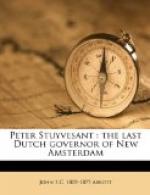It is very evident that Sir Henry Hudson was by no means a good disciplinarian. The authority he exercised over his crew, was very feeble. A mutinous spirit began already to prevail, and we are told that they threatened him savagely. It would appear that Sir Henry and his mate wished to repair to Newfoundland, and after having passed the winter, which was close upon them, there to resume their voyage, in search of a northwest passage, through Davis’s Straits. But the turbulent crew would not consent. They compelled the captain to turn the prow of his ship towards Europe. After the voyage of a month the Half Moon cast anchor in the harbor of Dartmouth, England, on the 9th of November, 1609.
It will be remembered that Sir Henry Hudson was an Englishman, though he was sailing in the service of the Dutch East India Company. When the Dutch Directors heard of his arrival in England, and of the important discoveries he had made, they sent orders for him immediately to repair to Amsterdam. At the same time the Dutch government claimed, by the right of discovery, all that portion of the North American continent along whose coasts Hudson had sailed and upon whose shores he had occasionally landed, taking possession of the same in the name of the Dutch government.
The English government, jealous of the advantage which had thus been gained by the flag of Holland, peremptorily forbade Hudson to leave his native country; and for several months the Half Moon was detained at Dartmouth.
CHAPTER II.
THE PROGRESS OF DISCOVERY.
Value of the Territory Discovered.—Fate of Hudson.—The Conspiracy.—Aspect of Manhattan Island.—The Trail which has Widened into Broadway.—The Opening Commerce.—The Fur Trade.—Visit of the English Man of War.—Exploring the Sound.—Commercial Enterprise Receives a New Stimulus.—Erection of Forts.—Character of the Fur Trade.
The Half Moon was detained in England eight months, and did not reach Amsterdam until the summer of 1610. The Dutch Directors, though disappointed in not finding in the region they had explored the much hoped-for Northwest Passage to the Indies, were somewhat elated by the magnificent discoveries which had been made. The territory they claimed, by virtue of these discoveries, extended from the mouth of the Delaware on the South, to Cape Cod on the Northeast. The grand river of Canada, the St. Lawrence, was deemed its northern frontier. Its western boundaries were unexplored and unknown.
This was indeed a princely territory to be owned by any power. The climate was as favorable as any to be found upon the globe. The soil was fertile, the landscape being picturesquely diversified by mountains and valleys. Vast forests, of the most valuable timber, covered immense portions. Wild fruits and nuts in great variety were found in profusion. The territory was watered by several truly magnificent rivers. The region was filled with game; and furs, of the richest kind and apparently in exhaustless quantities, could be purchased of the natives, at an almost nominal price.




